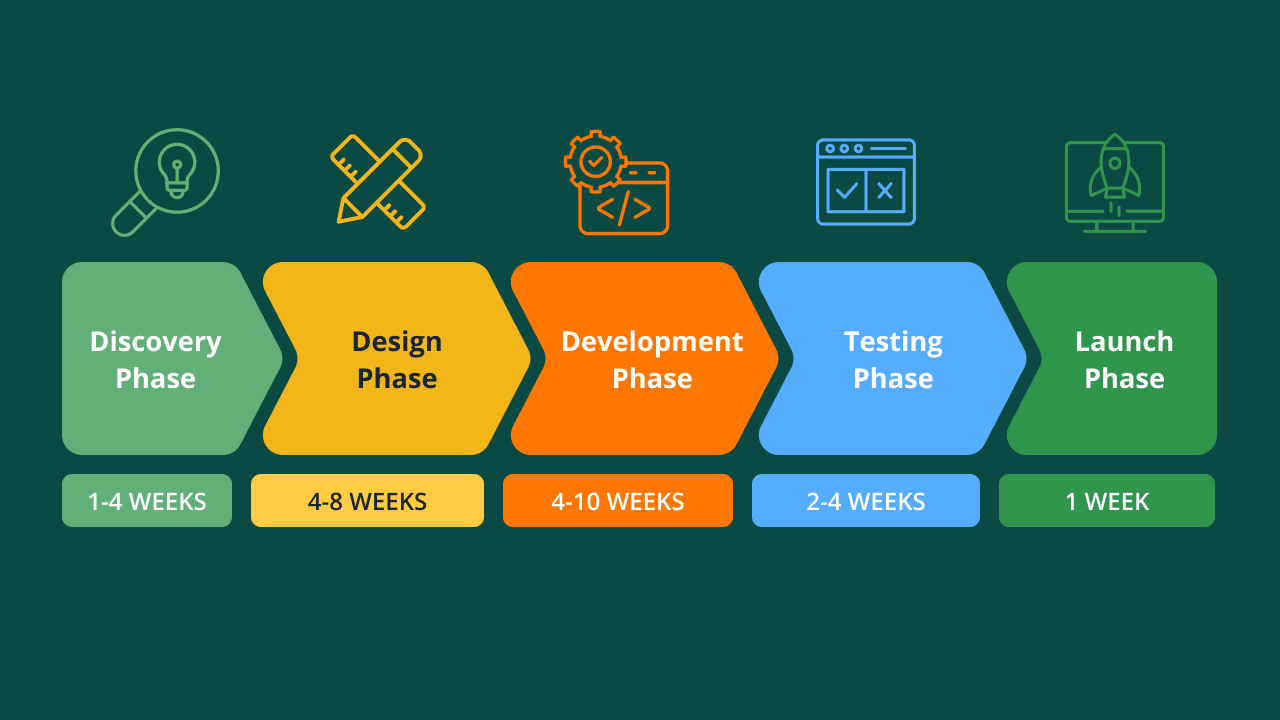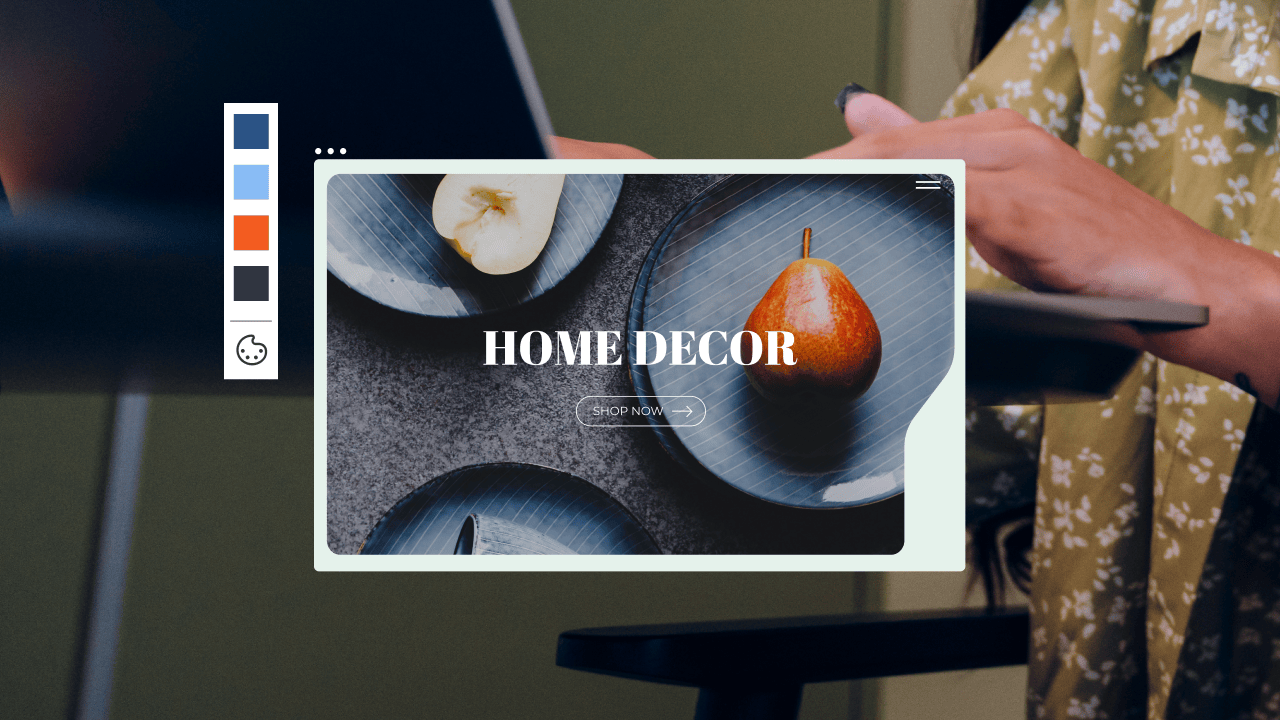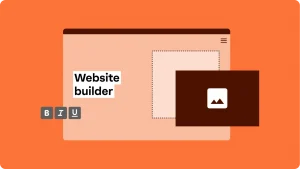Key takeaways:
- Learning the key differences between a website redesign and a refresh will help you choose the right approach based on your goals.
- There are signs that indicate it’s time for a website redesign. Recognizing when to redesign ensures your website stays competitive and aligns with your business goals.
- AI-driven tools and emerging technologies are transforming the website redesign process. Advancements like design systems, AI-powered personalization, and automation in web development can enhance user engagement and make the redesign process more efficient.
Is your website causing visitors to leave as soon as they arrive? If you’re seeing a high bounce rate and low conversion numbers, it strongly indicates that your site isn’t capturing attention effectively. The good news is you don’t have to start from scratch. A smart redesign can fix these problems, transforming your site into an engaging, user-friendly experience.
In this article, we’ll walk you through a clear 13-step plan for redesigning a website that looks great and performs better. You’ll also learn of best practices, associated costs and more.
What is a website redesign?
A website redesign is a complete overhaul of an existing site with the goal of improving its look, functionality, user experience, and overall performance. Unlike a refresh, which makes smaller updates like changing images, adjusting text, or fixing minor design issues, a redesign is more extensive and can include restructuring the layout, navigation, and design to meet current user expectations and industry trends. Website redesign and website refresh are both important to help maintain relevance, but a redesign goes deeper to enhance the site’s usability and effectiveness.
Redesigning a website is a big project that needs careful planning and attention to detail. Here’s a 13-step plan to guide you from start to finish:
- Step 1. Engage stakeholders to align on goals and vision
- Step 2: Analyze website performance metrics
- Step 3: Evaluate competitors’ websites for insights
- Step 4: Set clear goals and budget for the redesign
- Step 5: Create targeted buyer personas and content strategy
- Step 6: Build a clear sitemap and content hierarchy
- Step 7: Design wireframes and plan user interfaces
- Step 8: Prioritize usability over aesthetics
- Step 9: Ensure the design is mobile-responsive
- Step 10: Develop, code, and thoroughly test
- Step 11: Optimize your site for SEO
- Step 12: Migrate content safely and effectively
- Step 13: Perform pre-launch and post-launch checks
Step 1. Engage stakeholders to align on goals and vision
Hold meetings with stakeholders to get insights on their goals and expectations. Make sure the redesign is aligned with your business plans to improve both the user and business’ needs.
Step 2: Analyze website performance metrics
Review your brand’s current performance data, such as SEO rankings, traffic, page speed, and bounce rates. Use these data to identify weak points and set specific benchmarks for improvement so you can measure them against the redesign version.
Step 3: Evaluate competitors’ websites for insights
Check and study competitor websites to identify their strengths and weaknesses. Then identify design trends and functionalities that you can enhance or differentiate to offer your users a better experience.
Step 4: Set clear goals and budget for the redesign
Define specific goals, such as boosting conversions and improving mobile usability to align your actions to the goal. Then, allocate a budget that covers design, development, testing, and unforeseen expenses.
Step 5: Create targeted buyer personas and a content strategy
Make detailed personas to understand user behavior, needs, and wants. Then tailor your content strategy to meet those needs. This strategy will align your messaging and design for a seamless user experience.
Step 6: Build a clear sitemap and content hierarchy
Create a sitemap that outlines your content structure. Organize your content with relevant headers (H1, H2, H3, etc.) to help readers and search engines navigate your site effectively. This logical flow makes it easier for users to find the information they need.
Step 7: Design wireframes and plan user interfaces
Sketch wireframes for your web pages to help you envision the layout and content placement of your redesigned site. This visual blueprint ensures that the design is user-friendly before you move to the full design phase.
Step 8: Prioritize usability over aesthetics
Make sure the design is intuitive because this makes navigation easy and clear. Also, essential elements like calls-to-action (CTAs) should be prominent so users can act immediately and purchase. Always prioritize user experience over overly decorative elements.
Step 9: Ensure the design is mobile-responsive
Your design should be mobile-friendly. This means that your website can “resize” to different screen sizes without losing its functionality and visual appeal. A truly responsive design guarantees that a user on a smartphone, tablet, or desktop computer has an equally excellent experience.
Step 10: Develop, code, and thoroughly test
Test your design across different browsers and devices to ensure they work properly.
This phase turns your designs into a live, functional website. If you want full custom development, then your developers will write the code (HTML, CSS, JavaScript), integrate backend systems, and set up a CMS like WordPress for content management.
After coding, thorough testing is essential across these areas:
- Cross-browser compatibility. Ensure the site works on all major browsers.
- Device responsiveness. Test on multiple devices and screen sizes for proper scaling and usability.
- Functionality and user flow. Verify all buttons, links, forms, and processes (e.g., checkout) work smoothly.
- Performance and speed. Optimize load times using tools like Google PageSpeed Insights.
- Accessibility. Make the site usable for everyone, including those with disabilities (e.g., color contrast, alt text).
This step ensures the website looks great, performs well, and delivers a consistent, accessible experience.
Step 11: Optimize your site for SEO
Use proper HTML tags, optimize your images (by adding alt tags and compressing them), and maintain fast load times. Don’t forget to incorporate relevant keywords, metadata, and use clean, descriptive URL structures to boost your visibility in the search engine results pages (SERPs).
Step 12: Migrate content safely and effectively
Before you migrate your content from the old site to the new one, back up your files first. This ensures that you won’t lose any information when you start migrating them to the redesigned website.
Step 13: Perform pre-launch and post-launch checks
Test all functionalities such as links, forms, and checkout processes before you launch. This ensures that users won’t encounter any issues when you’re live. After launching your redesigned site, monitor for issues and gather user feedback to make necessary improvements to your site.
Get more detail from our quick guide on How To Plan a Website: A Simple Guide To Getting Started.
Design tips and user experience (UX) focus
UX is all about creating a smooth and enjoyable journey for website visitors. Below are some UX design principles to enhance the user experience.
- Use color theory to enhance user engagement
- Optimize typography for readability
- Maintain consistent design elements
- Use whitespace effectively
- Reduce form friction for higher conversions
Use color theory to enhance user engagement
Choose a harmonious color scheme with one or two primary colors and complementary accents. Make sure they have good contrast for accessibility, especially for colorblind users.
Optimize typography for readability
Select legible fonts like Arial, Helvetica, and Roboto and use appropriate font sizes for different screens. Don’t go crazy with the font usage—two or three fonts are enough for a clean, readable design.
Maintain consistent design elements
Make sure buttons and headers are uniform across pages. This will help users navigate your site more effectively and create a cohesive, professional appearance.
Use whitespace effectively
Use whitespace to separate content. This avoids clutter and gives each element room to breathe, which can enhance your site’s user experience and visual appeal.
Reduce form friction for higher conversions
To streamline the user experience and reduce your customers’ frustration, simplify forms by asking for essential information only, such as their name, email address, and payment details. Break down complex processes, like checkout, into smaller, easy-to-complete steps to make navigation more intuitive and manageable for them.
When to redesign your website
Knowing when to redesign your website is important to stay competitive and meet user needs. Here’s a checklist to help you decide if it’s time for a redesign:
- Poor site performance or slow load times. If your website takes longer than three seconds to load, you can lose visitors. Slow load times affect search engine optimization (SEO) and user experience. Use tools like Google PageSpeed Insights to analyze and improve your website’s performance.
- High bounce rates. If visitors leave your site within seconds without interacting, it’s a sign that your content or layout might not be engaging enough. Redesigning can help create a more intuitive and user-friendly experience to keep visitors around.
- Low conversion rates. If visitors aren’t completing the desired actions (like making a purchase or filling out a contact form), your website might need to be optimized for better user flow, clearer calls-to-action, or more compelling offers.
- Outdated design. An outdated website can make your business appear less trustworthy or professional. If your website looks like it’s from the early 2000s or lacks a modern, mobile-friendly design, it’s time to rethink the visuals.
- Negative user feedback. Pay attention to what your users are saying. If they find your site difficult to navigate or frustrating to use, a redesign can be the answer to these pain points. Collect feedback through surveys or usability tests.
- Mobile responsiveness issues. More users are accessing websites on mobile devices now. If your site isn’t mobile-friendly, you can lose a significant amount of traffic. Redesigning will help ensure a seamless mobile experience.
Real-world scenarios:
- Small business website. If you’re running a small business and your site hasn’t been updated in years, it’s probably time for a redesign. A fresh look, better functionality, and a responsive design could increase engagement and sales.
- eCommerce website. For an eCommerce store, low conversion rates or cart abandonment could indicate it’s time for redesign. If your checkout process is complicated, your product images are outdated, or your site isn’t mobile-friendly, a redesign can help simplify the user experience and improve conversions.
- Blog. If you’re running a blog and noticing high bounce rates, it might mean your content isn’t as engaging or accessible as it should be. A redesign could include features like a more organized layout, an updated color scheme, and better navigation. All of these make it easier for readers to enjoy your content and stay longer.
Website redesign vs. Website refresh
It’s good to know the difference between a full redesign and a simple refresh. Each option has its own perks, costs, and timelines, depending on what you want to achieve and how your site is doing right now.
| Aspect | Website redesign | Website refresh |
| Definition | A total revamp of your website’s design, structure, and functionality. It usually means big changes to navigation, layout, content, and the overall user experience. | This is more on tweaking the look and feel. Updating images, text, colors, and fonts without changing the core structure of the site. |
| When to use | – Website is outdated or hard to navigate. – You want to improve user experience, mobile responsiveness, or site performance. – Site’s poor structure or slow load times are hurting your SEO. – Rebranding or launching new products/services. | – Site still works well but needs update to stay relevant. – You want to add new content, refresh visuals, or update your branding without disrupting the user experience. |
| Example | – An eCommerce website with a complex checkout process and low conversion rates might need a redesign to simplify navigation, improve mobile responsiveness, and streamline the purchase flow. | – A blog with updated content but a slightly outdated design could use a refresh with new images, typography, and color schemes to keep it modern without changing its structure. |
| Cost | More expensive because it involves comprehensive changes. You might need to hire a team of designers, developers, and SEO experts. | More affordable since it typically only involves changes to the visual elements or content. |
| Time | Weeks to months, depending on the complexity of the site and the number of changes involved. | Can be completed in a matter of weeks or even days, depending on the scope of the changes. |
| Impact on branding | – Aligns your website with a new or refreshed brand identity. – Can help modernize your business image, update your brand’s voice, and improve consistency across all platforms. | Good for minor brand tweaks, such as updating logos, fonts, or colors to keep the site looking fresh without changing how the brand is presented. |
| Impact on SEO | – Can improve SEO if it involves optimizing the website’s structure, improving page load speed, and ensuring mobile-friendliness. However, it may cause temporary drops in rankings if not done carefully. | – Has minimal impact on SEO, as it typically doesn’t change site structure or functionality. – Updating content or images could slightly improve keyword relevance or page engagement. |
| Risk | Comes with higher risk if not done properly due to major changes to your site’s structure and user flow. | Lower risk because the core structure of the site remains the same. |
Cost breakdown and timeline for redesign
It’s important to have a clear understanding of both the costs and the timeline involved when redesigning a website. This helps set realistic expectations from the start. Below is a breakdown of the typical costs based on the type of website and a timeline to guide you through each phase of the redesign process.
Cost breakdown by website type
Small business website: From $2,000 to $5,000
Details: Small business websites usually have simple designs with a limited number of pages, content updates, and basic functionality. Costs can be lower if you use DIY options or website builders.
eCommerce website: From $3,000 to $75,000
Details: eCommerce websites are more complex due to product pages, shopping cart functionality, secure checkout systems, and payment gateway integration. Pricing can increase with additional custom features.
Corporate website: From $3,000 to $75,000
Details: Corporate websites typically require custom features, internal system integration, and a refined design approach. These websites usually have more pages, greater complexity, and a higher need for professionalism.
Blog or portfolio: From $2,000 to $15,000
Details: Blogs or portfolio websites are generally simpler and content-focused with a limited number of pages and features. They are more affordable, especially if you go for DIY tools like WordPress or Squarespace.
Custom web applications: From $10,000 to $100,000
Details: Custom web applications, such as those requiring advanced functionality, custom databases, and API integrations, involve the highest costs. These projects usually demand extensive development work and custom coding.
For a tailored solution, you can explore professional services such as website design services where a team of experts craft a website that’s aligned with your business goals and identity.
Factors influencing cost
- Complexity. More complex sites, like eCommerce or custom web applications, typically cost more due to the additional features and functionality. Custom designs and advanced features, such as payment systems and user accounts, raise the price.
- Agency vs. DIY. Hiring an agency for a professional redesign will generally cost more than doing it yourself with website builders or templates. Agencies provide more sophisticated designs, custom development, and ongoing support, but they come at a premium price.
- Design vs. functionality. Websites with complex functionality, like eCommerce sites, need more development and coding time, which can increase costs. Design-focused sites with basic functionality (like blogs or portfolios) tend to be more affordable.
Timeline breakdown by phase
A successful website redesign follows a clear, multi-step process. Here’s a breakdown of each phase, from the initial planning to the final launch.

Discovery phase (1 – 4 weeks)
This is where you define your website’s goals, target audience, and overall purpose. You should gather input from stakeholders and identify key features, functionality, and business goals as a guide for the redesign process.
This phase might take longer if there are a lot of stakeholders involved or if you’re still figuring out the website’s direction. The more clarity you have, the faster this phase will go.
Design phase (4 – 8 weeks)
During this phase, wireframes, mockups, and prototypes are created based on the discoveries made earlier. This is when the visual elements of the website are established. Feedback and revisions are common, so it’s important to plan for multiple iterations.
Development phase (4 – 10 weeks)
In this phase, the site is built and coded. Developers translate the design into a fully functional website. This includes integrating content management systems (CMS), adding necessary plugins, and configuring databases. Custom functionality like shopping carts or membership systems will be implemented at this stage. This phase can stretch out depending on the complexity and the number of features being developed.
Testing phase (2 – 4 weeks)
This phase involves checking the site’s functionality, performance, and usability. Testing should cover different browsers, devices, and screen sizes to ensure everything works seamlessly. It’s important to fix any bugs or issues during this phase to ensure a smooth user experience at launch.
Launch phase (1 week)
In the final phase, the website is launched to the live server. This involves final checks, transferring the website files to the server, and making the site available to the public. Post-launch testing and monitoring will also be done to address any issues that may arise after the site goes live.
How AI is changing website redesigning
As website redesigns evolve, tools and AI are transforming how websites are created and optimized. From AI-driven prototyping to personalized user experiences, new technologies are redefining the design process, giving businesses more efficient and innovative ways to engage users.
- Design systems and AI-driven prototyping. Tools like Figma, Sketch, and Adobe XD help create consistent, scalable designs. With AI features, these tools can suggest elements and automate adjustments. AI-driven prototyping tools like Framer and ProtoPie make it easy to create interactive prototypes for faster testing.
- AI-powered personalization. AI can personalize content and layout based on user behavior, making real-time changes like product recommendations to improve engagement and conversions.
- Emerging technologies. Voice search optimization, AI-powered chatbots, and augmented reality (AR) are shaping the future of website redesigns. These can enhance user interaction and eCommerce experiences.
- Automation in web development. Some website builders are augmented by the power of AI that speeds up the website building process. You only need to answer some questions about your business and the AI website builder will generate a website.
- Predictive analytics for design decisions. AI-driven analytics can predict the impact of design changes on user engagement and conversions, helping businesses make data-driven decisions.
Revamp your website with Professional Website Design Services
Redesigning your website is a big step in enhancing your online presence and ensuring that your site works to meet the needs of your business and your users. Whether you want to improve site performance, user experience, or align with a new brand identity, the process should be carefully planned and executed. With the evolution of AI, tools, and technologies, you can now streamline your redesign and create more dynamic, user-centric websites.
At Network Solutions, we offer Professional Website Design Services. Our design experts take the weight off your shoulders while you focus on running your business. We work closely with you to create a website that reflects your brand.
Let us help you elevate your online presence. Contact us today to get started!




